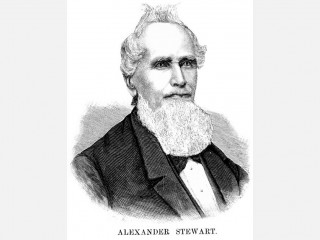
Alexander Stewart biography
Date of birth : 1803-10-12
Date of death : 1876-04-10
Birthplace : Lisburn, County Antrim, Ireland
Nationality : Irish
Category : Famous Figures
Last modified : 2010-11-19
Credited as : Entrepreneur, ,
In the mid-19th century Alexander Turney Stewart was America's leading retail dry-goods merchant and an outstanding dry-goods wholesaler. His innovations in merchandising profoundly affected American retail trade.
Alexander Stewart was born on Oct. 12, 1803, in Lisburn, County Antrim, Ireland. With his inheritance, he opened a retail store in New York City in 1823, having emigrated to the United States somewhat earlier. A merchandising genius, he introduced a new type of dry-goods store in 1846 that was the precursor of the department store. In this mercantile showplace, Stewart sold a wide range of merchandise. Successful, this store was expanded so that by 1850 Stewart had the largest establishment of this kind in New York City, the largest mercantile center in the nation. In 1862 he again pioneered when he erected a grander store constructed on iron structural beams.
Mid-19th-century America witnessed the development of three variants of mass marketing: the department store, the mail-order house, and the chain store. These all possessed certain common attributes, many of which Stewart innovated. For example, he early used the one-price system, without bargaining, as well as cash buying in large quantities and selling at low prices. These innovations are related to large-scale enterprise. "He was the first retailer to departmentalize his merchandise, thus preparing the way for the future department store." After all, a department store presupposes a degree of decentralization and autonomy for each of the departments. In an age in which domestic commerce was dominated by the wholesaler, Stewart employed vertical integration: he was his own wholesaler and manufacturer and also maintained his own European buying organization. These techniques reduced costs and selling prices. The result of such policies was an unequaled sales volume in millions of dollars. This merchant prince became one of the richest Americans of his day.
Another of Stewart's accomplishments was the creation of a sizable, effective sales and supporting staff. To motivate his managers, he allowed them to share in profits, though not in ownership. However, Stewart's enterprise began to decline as key personnel were not replaced and Stewart became involved in outside affairs. His enterprise did not survive mismanagement by those who succeeded him. The hulk of the concern was sold to John Wanamaker, the prime Philadelphia merchant, in 1896.
Outside of his business, Stewart's career was undistinguished, although he did sponsor one of the early "model towns," Garden City, N.Y. He became a War Democrat during the Civil War. Appointed secretary of the Treasury in 1869 by President Ulysses S. Grant, he never held the position, since business people were disqualified by law.
He died on April 10, 1876, in New York City, having profoundly affected American retail trade.
Ralph Merle Hower, History of Macy's of New York, 1858-1919:Chapters in the Evolution of the Department Store (1943), presents material on the history of retailing, as does John W. Ferry, A History of the Department Store (1960). Also useful is Philip S. Foner, Business and Slavery (1941).
Elias, Stephen N., Alexander T. Stewart: the forgotten merchant prince, Westport, Conn.: Praeger, 1992.
















